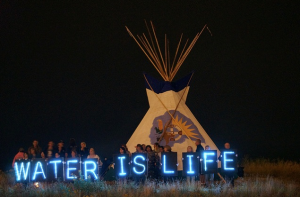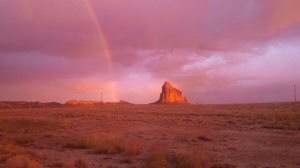I was born between the four sacred mountains of the Navajo Nation. When I give thanks, I am forever grateful for being born Diné. There is no one on this earth that can take that from me. Like my ancestors, like my grandmothers before me I will die a Navajo woman. They will RECOGNIZE me and for that I am FOREVER thankful. The earth between the four sacred mountains is my life. It is where I get my strength and ability to live. From a young age I was taught to respect the land and care for it, always. I was taught to live by our Navajo ways and those Navajo ways are higher than any other law. The Navajo way of being for me has always been and is the natural way of being, a natural law. As I get older I better understand the environmental impacts of development on my homeland, and the health impacts on/in my body. With this understanding and knowledge I have come to realize it is my responsibility as a Navajo woman to engage and protect my place, my homeland and my family. As a Navajo woman I am responsible for not only my children but my entire family, my clan, my community, the land, the water, and our ways of being. As an act of resurgence I am learning of the struggles being fought on the ground by Navajos (daily) to reclaim, regenerate our relationships with the land and with each other. I am positioning myself to be better acquainted with the knowledge and needs of my community. I have begun to make the critical reconnections to intimately know the needs of my community and of the land and water. I am taking the steps needed to stay tied to my family, my clan, my community so tha I am present, truly present. So that I am on the land, on Dinétah until the end of my life. So lest we forget these Navajo struggles & sacrifices (There are many more. I will update this post as time permits):

Addressing Uranium Contamination on the Navajo Nation (Photo Courtesy of http://www.epa.gov/region09/superfund/navajo-nation/contaminated-water.html )

Studying the effects of Uranium on the Navajo People – Photo courtesy of Four Corners Free Press – http://fourcornersfreepress.com/?p=978
URANIUM MINING AND CONTAMINATION OF OUR HOMELANDS
There are Navajo families that continue to lack piped water and must haul their own water from other sources, most of which are unregulated wells. Many of the water sources have been significantly compromised by chemical, bacteriological and uranium contamination. The contamination of our water sources has been an issue for decades. There have been unprecedented instances of death, cancer, birth defects, and other health related problems due to decades of hap hazard mining (Addressing Uranium Contamination http://www.emnrd.state.nm.us/mmd/marp/Documents/MK023ER_20081212_Marquez_NNELC-Acoma-Comments-AttachmentE-UExposureSummary.pdf also see http://www.ncbi.nlm.nih.gov/pmc/articles/PMC3222290/ ) Even after the mining boom of 1948 the Navajo people live on as Indigenous people of Dinétah. We continue live by the stories told by our ancestors. We continue to obey the signs shown to us by the land and stories given to us by the land. Navajo like many other Indigenous people have a legacy of resistance. We continue to survive attempts at annihilation and just as the Niłchʼi Diyin (holy wind) we are a people that is ALIVE and we will prevail even after the celebrations of the colonial government.

Snowbowl pipeline desecration. Photo courtesy of www.indigenousaction.org
DESECRATION OF SACRED SITES
As Navajo people our relationship to land is intimately reflected in the countless stories and majestic landscape of Dinétah. The land itself can summarize our long and rich experience. It is wholly capable of expressing a viewpoint, emphasizing relationable (family & community) cohesion and offers wisdom. The colonial mindset of some of our very own tribal leaders and that of the colonial government is one which continues to attempt to dismember the land from the Navajo people. Their hope is that our seperation from our homeland will result in a breakdown of spiritual values and Navajo ways of being. However, despite political, social, economic and environmental catastrophes the land and our ways of being continue to survive.
Tsoodził (Mt. Taylor) is facing threat of uranium mining by companies such as Roca Honda Resources.
Dook’o’oosłííd (San Francisco Peaks) is being desecrated by Arizona Snowbowl’s expansion and treated
sewage snowmaking.
Dibé Ntsaa (Mount Hesperus) is threatened by Wildcat Mine which is planning to mine gold, silver, and tellurium.
Dził ná’oodiłii (Huerfano Mesa) faces oil and gas drilling including fracking.
Ch’óol’í’í (Governador Knob) faces oil and gas drilling including fracking.
Dinétah: Holy Lands, place of Diné emergence into this world and where, today, multitudes of oil and gas wells extract fossil fuels from the land.
Dził yíjiin (Black Mesa) has been desecrated by Peabody since 1960s. Wells and springs have run dry due to mining related pumping of the N Aquifer.
Ch’óóshgai (Chuska Mountains) survived more than a century of unsustainable forestry practices, and near deforestation that resulted in the disappearing of springs, medicinal herbs and erosion. It is still in need
of reforestation.
Tsé’naa Na’ní’áhí (Rainbow Bridge ) Prayer offering sites have been covered by the waters of Lake Powell.
Bidaa (Grand Canyon Confluence) is threatened by the Grand Canyon Escalade which plans on building a large scale resort where the Little Colorado & Colorado
rivers meet.
The Colorado River and San Juan River have faced toxic contamination and over use.
(Navajo names of sacred sites and the way in which they are being threatened courtesy of Indigenous Action Media – http://www.indigenousaction.org/nnact/ )
HWÉÉLDI (THE NAVAJO LONG WALK)
Dee Brown’s Bury My Heart At Wounded Knee provides accounts of the ruthlessness, greed and murderous policies of the United States at Bosque Redondo.
During the autumn, Navahos who had escaped from the Bosque Redondo began returning to their homeland with frightening accounts of what was happening to the people there. It was a wretched land, they said. The soldiers prodded them with bayonets and herded them into adobe-walled compounds where the soldier chiefs were always counting them and putting numbers down in little books. The soldier chiefs promised them clothing and blankets and better food, but their promises were never kept. All the cottonwood and mesquite had been cut down, so that only roots were left for firewood. To shelter themselves from rain and sun they had to dig holes in the sandy ground, and cover and line them with mats of woven grass. They lived like prairie dogs in burrows. With a few tools the soldiers gave them they broke the soil of the Pecos bottomlands and planted grain, but floods and droughts and insects killed the crops, and now everyone was on half-rations. Crowded together as they were, disease had begun to take a toll of the weaker ones. It was a bad place, and although escape was difficult and dangerous under the watchful eyes of the soldiers, many were risking their lives to get away.
And no advocate of Manifest Destiny ever phrased his support of that philosophy more unctuously than he: “The exodus of this whole people from the land of their fathers is not only an interesting but a touching sight. They have fought us gallantly for years on years; they have defended their mountains and their stupendous canyons with a heroism which any people might be proud to emulate; but when, at length, they found it was their destiny, too, as it had been that of their brethren, tribe after tribe, away back toward the rising of the sun, to give way to the insatiable progress of our race, they threw down their arms, and, as brave men entitled to our admiration and respect, have come to us with confidence in our magnanimity, and feeling that we are too powerful and too just a people to repay that confidence with meanness or neglect—feeling that having sacrificed to us their beautiful country, their homes, the associations of their lives, the scenes rendered classic in their traditions, we will not dole out to them a miser’s pittance in return for what they know to be and what we know to be a princely realm.”
When the Bosque’s grain crops failed again in the autumn of 1865, the Army issued the Navahos meal, flour, and bacon which had been condemned as unfit for soldiers to eat. Deaths began to rise again, and so did the number of attempted escapes.




